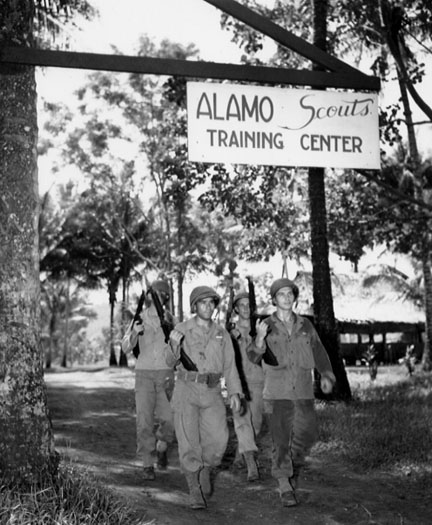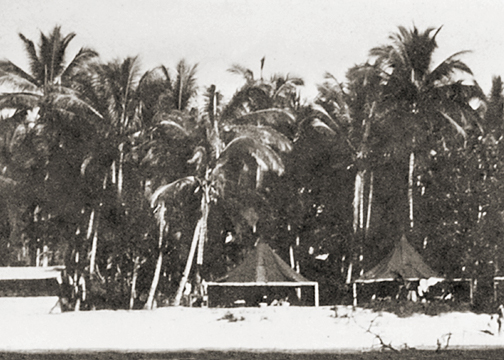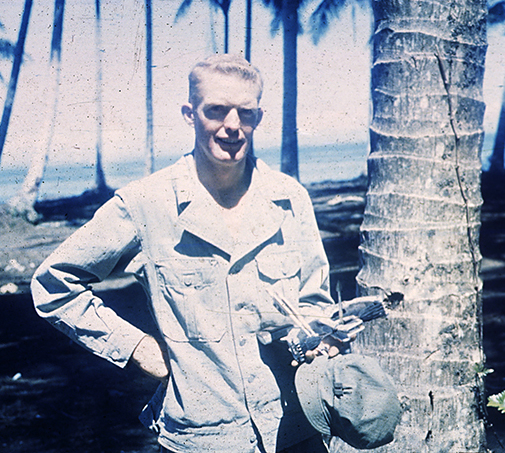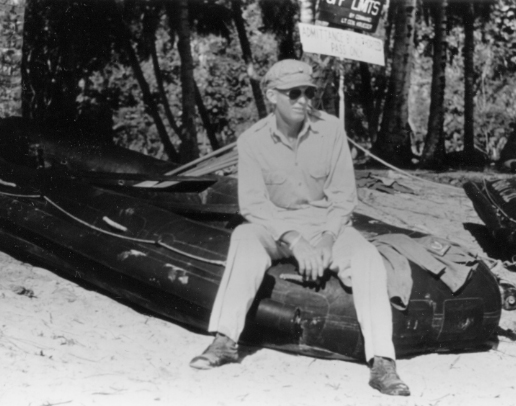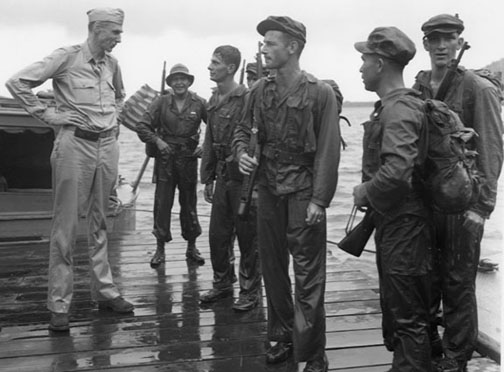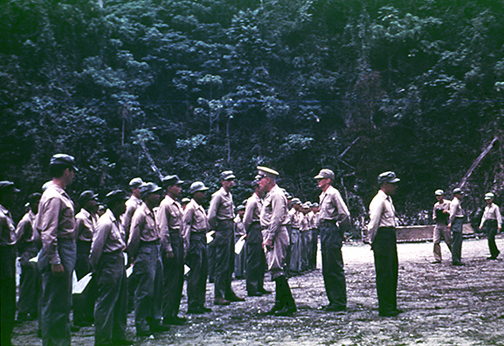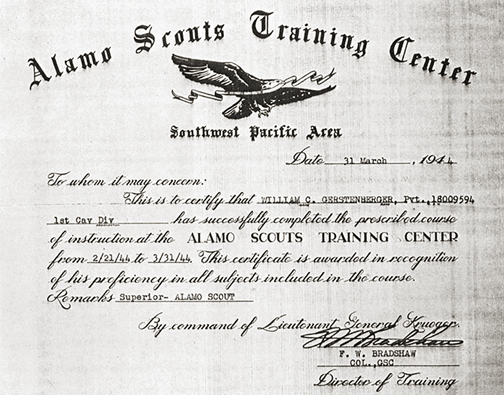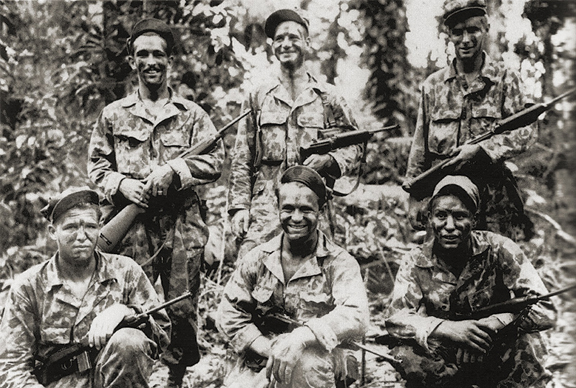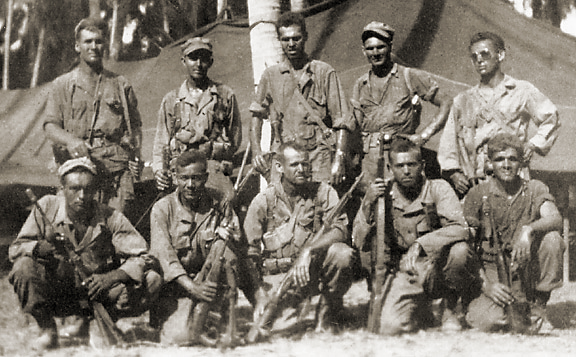|
|
The Alamo Scouts by Les Hughes © by author 1986 |
|
|
|
In an effort to provide his Sixth
Army (then known as the "Alamo force"1) with
accurate, timely, and specific intelligence, General Walter Krueger
issued the following order on 28 November 1943:
By placing the ASTC directly under the Sixth Army's Intelligence Section (G-2), General Krueger provided Army headquarters with an organized reconnaissance agency able to obtain strategic and tactical intelligence. While General Krueger’s order can be considered to mark the birth of the Alamo Scouts, the organization’s bloodlines can be traced, surprisingly, to the US Navy. Confronted with a similar need for intelligence, the Navy had established a unit known as the Amphibious Scouts. Created in the Solomon Islands and operational by July 1943, the Amphibious Scouts comprised volunteers from both the Australian and American Armed Forces. The Australian members brought to the unit experience in jungle operations and, especially, firsthand knowledge of the region in which the unit would operate. The unit was organized into teams that had a definite all-service character. One team, for example, comprised an Australian team leader, one US sailor, one US Marine, one US soldier, and five New Guinean natives. Amphibious Scouts received training in a number of areas—including the care and handling of boats, marksmanship, physical conditioning—but the subject that demanded more of their time than any other was the study of pidgin English.2 As the name of the unit implies, the teams were inserted amphibiously into Japanese-held territory. Teams were taken by PT boat as close to shore as possible under the cover of darkness; then paddled the remaining distance to shore in rubber boats. Teams would gather intelligence for periods of a few days or a few weeks, depending on the mission, and then rendezvous with a PT boat for return to base. In December 1943, the US army, learning that the Amphibious Scouts were to be disbanded, made arrangements to take possession of the Amphibious Scouts camp, then located at Kalo Kalo on Fergusson Island, New Guinea. Three infantrymen from the 32nd Infantry Division, all veterans of the Amphibious Scouts, were assigned to the camp staff as instructors. This camp, its facilities expanded and improved, would be the first of five Alamo Scouts Training Center sites.3
As construction of the ASTC’s facilities progressed, the process of selecting the first class began. The first step of the process was to solicit volunteers from specific Army units in SWPA for “an unusual mission.”5 The units were asked to screen the volunteers and, by eliminating all but the most promising, to reduce the size of the group to a manageable number (for a division, no more than about 100 volunteers). Members of the ASTC staff would then visit the unit and interview those who had passed the initial screening. A volunteer could expect to be asked to give his reasons for volunteering and to describe contributions he could make to the Scouts. Volunteers who expressed a burning desire to kill Japs would never see the ASTC.
Entrance to first ASTC, Fergusson Island, New Guinea, 1944. (Signal Corps) In selecting men for training, the ASTC staff were guided by these thoughts:6 “Foremost of the requisites of a
good Scout is that he be intelligent. This does not mean ‘well educated.’
He need not hold a degree, he need not even have completed high
school, though experience has proved that the better Scouts are men who
have at least completed high school. He must have ‘horse sense’—the ability to think logically
and make sound deductions. “Physically, a Scout need not be
a big man nor have the frame of an athlete. He must be strong enough to withstand fatigue on arduous marches
and he must have no physical defects or debilitating diseases. His vision must be clear without the use of glasses and he must
be a capable swimmer. This
does not mean that he is merely able to swim. It means that he must be able to swim in rough surf or over
distances up to at least a half-mile. His physical vigor and resistance must be such that he is able to
travel for weeks without the need of medical attention, since normally
it will be impossible for him to get such attention. “Hand in hand with his
intelligence and physical fitness, a Scout needs courage and an
attribute which may be called daring or a spirit of adventure—and this
is to be distinguished from recklessness and lack of reasonable
judgment. “Scouts are often called upon to
make marches over torturous terrain, up to 30 or 40 miles with little
rest and little food. Trails
and easy-going are normally forbidden him since he must not be seen. A man without grit cannot do
it. It takes courage, too, to get into a riverboat with five or six
other men, paddle silently through darkness and land on any shore where
there are no friendly troops. Scout
teams never know whether they have gone undetected or whether they are
paddling into the hands of an alert enemy. They do know that, if they are caught, there’s virtually no
hope of assistance. They must bear the risk. “Being naturally observant is
part of a Scout's equipment, and in this respect, men from small
communities in rural areas seem most gifted. City-bred men are not excluded,
however. Some of them have made excellent scouts. In basic training, all soldiers get instruction in scouting and
patrolling, the use of the compass, and the use of cover and concealment.
If they have
not shown a natural aptitude for the subjects, it is not likely that
they would make good scouts, and time does not permit ‘starting from
scratch.’ “Proper temperament or
personality is the last requisite, but certainly not the least important.
Teamwork is the
key to successful scouting, and not every man is willing or
temperamentally suited to mold himself into part of a small unit. Certainly initiative and individuality are desirable, since no
one wants to work with a ‘deadhead,’ but a scout must harmonize his
individualism with that of other members of his team. Being bellicose, loud, ‘mouthy’—being self-centered,
contemptuous of others’ opinions, unamenable to compromise, he will
not succeed in this field.” To emphasize the importance of a
volunteer’s temperament and his ability to work with other as a team,
General Krueger liked to tell the story of the man who was too smart to
be a Scout.7 The man was a lawyer and older than most of the other
volunteers. In the inevitable “bull sessions” that took place among the
volunteers, the man always had the last word and never lost an argument,
a fact that did not go unnoticed by the staff. After three weeks, the man was returned to his
unit. He could not understand why. The first ASTC class, comprising six officers and 38 EM drawn from the 32nd Infantry Division and the 158th Infantry Regiment, convened on or about 1 January 1944.8,9
ASTC, Hollandia, Dutch New Guinea (H. A. Williams) More than one volunteer must have
been surprised by the comparative luxury afforded by the ASTC
facilities: Floored and screened-in showers and mess hall, a spacious
dayroom, movies and electric lights (even in the tents). There were other aspects of the ASTC that made it unusual, if not
unique. There was never a
formal reveille (although everyone was up as early as those in units
with reveille), rarely a prescribed uniform, and a barely discernible
distinction between officers and EM.9
This atmosphere reflected the understanding that the volunteers
were seasoned soldiers, not raw recruits, who had come to the ASTC to
learn, in the brief time available, the skills and teamwork required for
scouting. The six-week training course began
with an orientation speech by which the Director of Training told the
volunteers what would be expected of them. “... you will certainly agree
that this is the nicest all-around camp that you have attended in this
theater. It is a good camp
because all have worked together to make it so. You are expected to help keep it that
way. A part of your training and a thing you will be strictly graded
on is the manner in which you conduct yourselves. You may have had the idea that Alamo Scouts is an organization of
cut-throats and toughs. We
wanted you to be tough—just as tough as you can make your selves, but
we do not have any place in this organization for A TOUGH. This type of work does not call for bums and
tramps. It calls for the highest qualities of soldiering. Self-discipline is one of the first
attributes. Be considerate of your fellow soldiers and of temperate
disposition... You will be treated as individuals and as
men—gentlemen, if you please. You will be expected to respond in a similar manner. “Remember, you were not asked to
come to this Training Center. It
is our understanding that each and every one of you is a volunteer of
his own free will and accord. If
there is any one of you who has any reservations, mental or otherwise,
make yourself known to the Director of Training and you will be released
to return to your organization without any questions... You will be
closely observed during all of the six weeks you are here. If it is found that you are not mentally, temperamentally or
physically fit and up to the standards required; if it is found that you
are not giving it all you have; if it is found that you are not
sincerely trying—you will be returned. Time is too precious to waste on those who do not ‘fit.’
There are no disciplinary problems here. Breaches of discipline are quickly disposed of by returning the
violator to his unit. “...The officers of the staff are
here with the single thought of furnishing you with their best in the
way of training. There is
no need for you to have the slightest fear of them. They are ordinary human beings, just as you and I are, and they
hope you will consider them as such in your contacts with them. Practically all of us started in the Army as privates, including
myself. Most of us are
civilian soldiers doing the simple job of trying to help our country win
a war. If you have any
suggestions to offer, any real criticism or complaint or anything else
you want to get off your chest, we encourage you to discuss it with a
member of the staff; or, if you are hesitant to do that, then simply
write a note and drop it in the mailbox in the day room. You do not even need to sign it... The relationships here are
very informal, based as they are on mutual respect and sincere effort. “... At the conclusion of this class, some of you will be selected as Alamo Scouts and retained to execute such reconnaissance missions as the Army commander may desire. The majority of you will be returned to your units where your training will stand you in good stead and where you will be available to your division, regimental and battalion commanders for their missions. A few of you will not make the grade for one reason or another. In any event, you will be better soldiers for what you have received here and it is hoped that you always carry with you the tradition and esprit de corps of the ‘Alamo Scouts’”.10
Several specialized weapons were tested at the ASTC, including this OSS-developed crossbow, held by Capt. Homer "Red" Williams, a member of the ASTC staff who became its second Director. None of the specialized weapons was judged practical for use by the Scouts. (H. A. Williams) The class was organized in teams of
one officer and, typically, six to ten EM. (The number of EM assigned to a team varied according to the
ratio of officers to EM in the class.)
The makeup of the teams was not static throughout the course. Some shuffling of personnel was necessary to equalize the size of
the teams in the face of attrition that ran as high as 40% during the
first two weeks. And
some shuffling was done by the staff to provide a trainee with the
opportunity to work with as many other trainees as possible and to allow
the staff to better evaluate how a trainee functioned in teams. The six-week course was divided into two phases. The first phase, lasting 3½ weeks, was devoted to classroom instruction in specific subjects and to brief exercises in the immediate vicinity of the camp.11 Subjects covered included use of compass, cover and concealment, first aid, marksmanship, boating, map reading, care and use of radios, panoramic sketching, fruits and vegetables, and Japanese weapons.12 Ninety minutes each day were devoted to a physical conditioning program that included judo and swimming. Trainees were also required to negotiate a live-fire jungle infiltration course during which expert Scout marksman carefully placed shots from Japanese weapons inches from each trainee. Two subjects that were new to most trainees, and to which many hours were devoted, were the use of rubber boats and night amphibious operations.13
Capt. H. A. Williams and one of the rubber boats used by the Scouts. (H. A. Williams) The last two and a half weeks were devoted to strenuous field problems requiring the utilization of the skills learned during the first phase. Great effort was made to ensure that the problems were conducted under conditions as realistic as possible, and, in some instances, exercises were conducted in areas with a light Japanese presence. Some exercises pitted Scout teams against one another. Included in this category were Surprise Problems in which teams were awakened in the middle of the night and presented with the exercise scenario. This type of training was a learning experience both for trainees and the members of the staff who accompanied them as observers. The performance of each team was critiqued after every exercise. (On one occasion, the members of an entire team were returned to their units for omitting mention of problems that arose because of personal conflicts among members of the team.) Throughout the exercises, the importance of attention to detail and careful planning was emphasized. This training phase culminated in a 26-mile jungle hike with full equipment, a final hurdle that a number of trainees failed to clear.14
MG F. H. Osborne talks with Scouts after a demonstration of swimming in full gear (Signal Corps) It was never the intention of the
ASTC staff that everyone who successfully completed the training program
would be retained as an Alamo Scout: that honor fell only to the best.15
As the first class drew to a close, the staff was confronted with
the problem of how to determine who among the graduates were the best. A selection scheme based on three factors was
adopted. Two of the factors—evaluations of the ASTC staff and projected
manpower needs of the Scouts—were to be expected. The third factor was
unusual. In the final week of training, each EM was asked to submit, by
secret ballot, the names, in order of preference, of the three officers
and five EM with whom he would most want to serve on a Scout team. Officers were asked to submit a secret ballot listing the EM they
would want on their team.16
Gen. Innis Swift, 1st Cav Division, visits an ASTC graduation ceremony. (H. A. Williams) A trainee learned the results of
the selection process on graduation day. In a ceremony at the ASTC, the Director of Training congratulated
each man and presented him with a diploma. The Director did not identify those who had been retained as
Alamo Scouts, but the diplomas did.17
Those not retained returned to their parent units, where many
were utilized as scouts.
After graduation, teams were formed
from those who had been retained as Scouts. Each team comprised five or six EM and one officer, usually a
lieutenant, who acted as the team’s leader.18
An effort was made to keep each team intact, but as Scouts
returned to their parent units some change was inevitable. Contrary to some claims19, none of the Scout teams was configured to comprise only airborne qualified personnel; neither did any Scout receive airborne training during the six-week ASTC course or while a member of a Scout team.20 According to a roster of ASTC personnel published in December 1944, there were only six Scouts whose parent units were airborne: three from the 503rd PIR and three from the 11th Airborne Division. Two of these men—Lieutenants William Nellist and Tom Rounsaville—were team leaders, and the other four paratroopers were assigned to the team of one or the other. The number of jump qualified men in these two teams may have led some to believe that they were configured with airborne operations in mind. But the evidence indicates that this was not the case; neither does it appear that there were plans to employ Scouts in an airborne capacity.8,21 The Alamo Scouts was not a TO&E
organization; all Scouts were assigned to the ASTC on temporary duty (TDY)
from their parent units. The
TDY status could be a liability when it came to promotions, which were
awarded by the parent units and not by the ASTC. In order to satisfy promotion criteria, it was often necessary
for an individual to leave the Scouts and return to his unit. The Scouts from the first ASTC
class did not have to wait long to test their skills. Near the end of February 1944, a team led by Lt. John R. C.
McGowan was given the mission of conducting pre-invasion reconnaissance
of Los Negros Island in the Admiralties. The invasion of the Admiralties was originally planned for April 1944. Using a submarine, a reconnaissance party was to be put ashore on Manus Island and spend a few weeks gathering information before the invasion. But because of the success of Allied landings at Arawe, Cape Gloucester, and Saidor, the timetable for the Admiralties invasion was moved ahead a full month. Enemy activity in the Admiralties by this time was quite low, and on Los Negros there appeared to be none at all. Allied aircraft had buzzed the airfield at Momote without detecting an enemy presence and without drawing fire. The invasion was shifted from Manus to Los Negros. The revised invasion plan called for a reconnaissance in force by a reinforced squadron of the First Cavalry Division. If this force found the enemy presence to be sufficiently weak, the reconnaissance in force would become an invasion. It was decided to insert a team of Alamo Scouts on Los Negros 48 hours in advance of the landing in force to determine the enemy situation in the Momote area. A diversionary air strike was to be conducted on the Momote airstrip at the time of the Scouts’ landing. At 0330 on 26 February, wearing camouflaged jungle suits and ponchos, and carrying carbines, grenades, and a two-day supply of "K" rations, the Scouts boarded a PBY Catalina for the flight to Los Negros. One Scout carried an SCR 300 radio for communication with the PBY. Unable to land because of weather conditions, the PBY returned with the team at 0830. At 0300 on the following morning, the team again departed for Los Negros. This time the PBY was able to land, but at 0645, in broad daylight, and one half-mile offshore, twice as far as planned. To make matters worse, the nervous pilot taxied the plane faster than the Scouts felt was necessary, making debarkation very difficult. The long trip to the beach was made without the diversion of the air strike on Momote, which was scheduled for 1000 hrs. Upon reaching the beach, the Scouts deflated their boat and proceeded on an azimuth that would take them to the airstrip at Momote. Movement through the heavy rain-forested area was slow and navigation by compass essential. After traveling for two hours, the Scouts saw the first signs of a Japanese presence—Conda vines strung from tree to tree about five feet above ground as guides for night travel. They encountered more evidence as the day wore on: a network of freshly-dug, camouflaged trenches; positions that appeared to be machine-gun emplacements; a bivouac area. A Japanese soldier suddenly materialized on a trail near the team’s position. The soldier stopped about 15 feet from the team leader and looked around, at one point directly at the team leader. The team leader was well served by his camouflage suit and his mud-streaked face, and the soldier continued on his way. At another point, the Scouts' line of travel intersected an unseen trail. When the team was about 10 yards from the trail, they were again forced to "freeze" while a group of 15 Japanese soldiers, apparently a work party, passed by. The Japanese appeared to be healthy and well fed, and their uniforms were well-kept. It was evident that reports of a Japanese evacuation of the area were not well founded. Confronted with an impassable stream between them and the airstrip, and with increasing enemy activity in the area, the team began the return trip to their landing site at 1300 hrs. The team became separated when the process of crossing a trail, one Scout at a time, was interrupted by the appearance of a group of Japanese soldiers. At 1800 hrs the team regrouped at the landing site and, after reconnoitering the area and establishing security, settled in to await the return of the PBY the next morning. At dawn, radio contact was established with the PBY, and a brief report of the mission was transmitted in case the pickup failed. The report, wherein it was stated that the area was “lousy with Japs,” made such an impression on the pilot of the PBY that, after nearly running over their boat, the team was picked up essentially on-the-fly, leaving boat and paddles bobbing in the plane’s wake. Upon landing, team leader McGowan boarded a PT boat and was taken to the 1st Cav’s convoy, already steaming toward the Admiralties, where he delivered a detailed report of the mission to the commanding officer of the 1st Brigade. The intelligence gathered by the Scouts was of great value in selecting targets on Los Negros to be bombed and shelled, and in planning the initial invasion. When the Americans landed on Los Negros, they expected to find the Japanese present in force, and they did. A report of the Admiralty Island operation stated: “on the evening of D minus 1 day, information was received that put an entirely different aspect on the whole operation. Army Scouts who had gone ashore that day, or the previous, on Los Negros Island from a Catalina, reported that the area southwest of the Momote airstrip was ‘lousy with gaps.’ This laid the previous intelligence information from a reconnaissance open to suspicion. The need for all available gunfire was apparent. Subsequent developments prove that the Scouts were more nearly correct—within a week after the initial landing the First Cavalry Division had buried a Jap for each cavalryman landed on D-Day, with estimated total garrison of between 4,000 and 5,000 thousand troops”.22
Team of LT John R. C. McGowan (rear, center) after their reconnaissance of Los Negros. (Signal Corps) Although the Scouts reassessed some of their operating procedures as a result of the mission (e.g., the use of the PBY with its requirement of fair weather; daylight insertion of teams), the soundness and practicability of the Scout concept of advanced reconnaissance was clearly proved. The Los Negros mission served as the prototype for advanced reconnaissance operations conducted during the New Guinea campaign. The invasions of Madang, Wewak, Sarmi, Biak, Noemfoor, Sansapor, and Japen Island were all preceded by reconnaissance operations conducted by Scout teams.23 Operations of this type were of fairly short duration, typically only a few days. The missions for which the Scouts are best-known are, ironically, those for which they were not primarily trained and which they rarely were called upon to conduct: raider missions. The most publicized of these missions was the Cabanatuan prison raid—a raid, with a reinforced company from the Sixth Ranger Battalion, to liberate Allied POWs at Camp Pangatian, Cabanatuan City, Philippines.24,25 The teams of lieutenants
William Nellist and Tom Rounsaville, along with Lt. John Dove as contact officer, were chosen to participate in the
raid. Four months earlier,
these two teams, with Lt. Dove as contact officer, had rescued 66 Dutch
and Javanese civilians held prisoner in the Cape Oransbari area of New
Guinea.26
The Scouts had killed at least 18 Japanese soldiers On 27 January 1945, the two Scout teams left Sixth Army Headquarters and proceeded to the guerrilla headquarters of Capt. Robert Lapham, in Guimba. Leaving Guimba that same evening, the teams traveled all night and reached the vicinity of the prison the following morning. Civilians and guerrillas were dispatched to begin surveillance of the camp. On 29 January, Company C of the 6th Ranger Battalion, reinforced by the 2nd Platoon of Company F, left Sixth Army Headquarters with Lt. Dove as guide. Traveling mainly after dark, the Rangers halted about two miles north of the prison. On the morning of 30 January, the Scout teams took positions within about 700 yards of the camp. Lt. Nellist, accompanied by Pfc. Rufo Vaquilar, crawled to an empty hut 200 yards directly north of the prison gate. From their vantage point in the hut, the two Scouts were able to observe the positions of the Japanese troops, which they noted on an aerial photo. The photo was carried to the waiting Scouts and to Lt. Dove, who carried it, by native pony, back to the commander of the Ranger force. The Rangers reached the Scouts' position at about 1800 hours, and the details of the plan for the raid were finalized. As soon as it was dark, the raiders began crossing the 700 yards of open ground to the prison. The plan called for the Scouts to remain at the prison gate until the attack was initiated, after which their primary responsibility was to act as guides for the prisoners as they were freed. As the attack began, three mortar rounds from inside the camp fell near the gate, wounding two Scouts. Lt. Nellist moved immediately into the area in the camp from which the mortar fire was coming and directed the fire of a group of Rangers, silencing the mortar. Lt. Dove entered the prison compound to hurry the evacuation, while Scouts not required as guides remained at the prison gate as a rearguard. When the main body of prisoners reached cover north of the prison, all the Scouts assembled on the north bank of the Pampanga River, where they formed a firing line to cover the removal of the wounded and stragglers. The Scouts remained in the area after the prisoners had been evacuated and, the following day, located and buried the two Rangers killed in the raid. On 1 February, the two teams returned to Sixth Army Headquarters. But Lt. Dove's work was not yet finished. Responding to a report that one prisoner had been left behind and had been taken to a guerrilla camp by civilians, Lt. Dove went to the camp and evacuated the last prisoner. Twice Lt. Dove returned to the prison to recover documents and to pay civilian cart drivers who had participated in the raid.27
Members of the Nellist and Rounsaville Teams after the raid on the Cabanatuan Prison Camp. Back row (L-R): G. Cox, W. Wismer, H. Hard, A. Smith, F. Laquier. Front row (L-R): G. Kittleson, R. Vaquilar, W. Nellist, T. Rounsaville, F. Fox. Three team members (T. Siason, S. Asis, A. Alfonso) who participated in the raid are not in this photo; neither is LT J. Dove, the teams' Contact Officer. (W. E. Nellist) The raid was a tremendous success. An estimated 511 prisoners were rescued at a cost of two Rangers killed and two Scouts wounded. One prisoner died during the raid, apparently from a heart attack. Lieutenants Nellist and Rounsaville received the Silver Star and the enlisted Scouts the Bronze Star. And a Distinguished Unit Citation was awarded to participating Rangers and Scouts.28 The publicity generated by the Cabanatuan Raid led the Army to lift the classified status of the Scouts. A war correspondent for The Saturday Evening Post was allowed to interview the Scouts. The resulting magazine article afforded the public its first in-depth look at the Alamo Scouts.29 After the invasion of the Philippines, the general nature of the Scouts’ missions changed somewhat. In addition to performing advanced reconnaissance, the Scout teams were active in coordinating the activities of interior guerrilla units, establishing radio intelligence nets behind Japanese lines, and in reporting the concentrations and movements of enemy troops. In keeping with this expanded role, the duration of the Scouts’ missions increased, often to weeks or even months. By July 1945, Scouts were training for reconnaissance operations for Operation Olympic, the invasion of the Japanese home islands. On August 13, four days after the second atomic bomb was dropped on Japan, Alamo Scout teams in the field were ordered back to the ASTC. And on September 2, the day Japan formally surrendered, training of the ninth, and final, Scout class ceased, two weeks early.30 There was no formal deactivation of the Alamo Scouts. Scouts and camp staff who qualified were returned to the States under the point rotation system. Scouts who lacked the requisite number of points could return to their parent units to await rotation, or they could proceed with the remaining Scouts to Japan, there to be attached to the 6th Ranger Battalion. Officers were given the additional option of joining Sixth Army's Intelligence Section. By December 1945, the Scouts who had gone to Japan had been reassigned or rotated home. Thus, without fanfare or ceremony, the Alamo Scouts was disbanded, never to be reactivated. Eight classes were formally graduated from five ASTC sites. Although the ninth class was in progress at the end of hostilities, its members are counted as having graduated (indeed, a few from this class were retained and accompanied the remaining Scouts to Japan). Of the approximately 700 candidates who entered Scout training, an estimated 300 graduated. And from the graduates, 118 EM and 25 officers were retained as Alamo Scouts.31 The total strength of the unit at any given time never exceeded about 60 EM and 10 officers.32 During the 20 months the unit was operational, Alamo Scouts spent 1,482 days in the field conducting 106 missions.33 This number includes eleven missions by Scout teams whose operational areas, late in the war, came under control of the Eighth Army, which referred to the teams as "Octagon Scouts" in its operational reports, a practice that General Krueger brought to an abrupt halt. Although a few Scouts were wounded during missions, not a single Scout was killed—a remarkable record when one considers the risks inherent in their missions. The record the Scouts compiled in conducting their missions is a testament to both the quality of their training program and the effectiveness of the Scout selection process. And one should not underestimate the importance of the close, personal interest that General Krueger had in the Alamo Scouts—in a sense, the Scouts were Krueger's unit. (Alamo Scouts served as Krueger’s personal bodyguard during his forays into the field and as his honor guard in Japan.) Krueger's patronage ensured that no door in the Sixth Army was closed to the Scouts, especially in the critical task of recruiting the best personnel available, from which only the best were retained. Although the Alamo Scouts had no motto, they justifiably could have chosen The Best of the Best. In 1988 the Alamo Scouts were included in the lineage of U.S. Special Forces, and veterans of the unit were awarded the Special Forces tab. Endnotes 1. General Krueger’s choice of “Alamo” probably reflects Sixth Army’s having been activated at Fort Sam Houston. 2. Milton H. Beckworth, private communication. 3. The other sites were Mange Point, Finschafen, NG; Cape Kassoe, Hollandia, DNG; Abuyog, Leyte, PI; Mabayo, Bataan, PI. (see www.alamoscouts.org) 4. Col. Bradshaw was the first of three ASTC Directors. His successors were Homer A. Williams and Gibson Niles, each appointed from the ASTC staff. 5. One sailor was selected for training, but he failed in the final week. 6. “Alamo Scouts,” Intelligence Bulletin (Military Intelligence Div., War Dept., June 1946) p. 31. It appears that the original source of these guidelines was a Sixth Army G-2 document. 7. Homer A. Williams, private communication. 8. Louis Hochstrasser, “They Were First: The Story of the Alamo Scouts” (Photocopy of manuscript, 1944). p. 5. Hochstrasser, a member of the second ASTC graduating class, served as the Center’s Adjutant. 9. Two magazine articles on the Scouts (“Alamo Scouts, US Sixth Army 1943-45” by Raymond Johnson and Alfred Hahn. Plate No. 499, The Company of Military Historians; and “The Alamo Scouts,” by Maj. George R. Shelton, Armor Magazine, Sept-Oct 1982) state that the first class convened on 27 December 1943. While that date may be correct, I have been unable to determine these authors’ sources of that date or to independently verify it. 10. Excerpted from the orientation for the sixth ASTC class. 11. LTC Gibson Niles, “The Operations of the Alamo Scouts (Sixth U.S. Army Special Reconnaissance Unit)” (The Ground General School, October 1949). 12. From the training schedule of the sixth ASTC class. 13. Arguably, these were the most dangerous activities in which Scout trainees participated. In October of 1944, two members of the fifth class drowned during exercises in heavy surf at Tami beach near Hollandia. 14. Lance Q. Zedric, Silent Warriors of World War II (Pathfinder Publishing of California. Ventura, 1995). p. 84. 15. A few graduates had come to the ASTC knowing they would not be retained as Scouts because their parent units had stipulated that they be returned to assist in the formation of the units’ own reconnaissance elements. 16. Hochstrasser, p. 6. Zedric reports a slightly different voting scheme, which he infers from a sample ballot for enlisted trainees of the first class—a copy of which he generously provided to this author. On that ballot, the trainee was asked to twice list, in order of preference, the names of the three enlisted trainees he would want to accompany him on a four-man patrol in enemy territory: first, limiting his three choices to members of his own team; second, to include any enlisted trainee in the class. And he was asked to briefly give reasons for each choice. 17. The diplomas of those retained from the first three classes bore the notation “Superior—Alamo Scout” or, according to Zedric (Silent Warriors, p. 87) “Excellent—Alamo Scout” or “Superior—Selected for Alamo Scouts.” The diplomas of those retained in later classes often bore simply the notation “Alamo Scout.” Similarly, the diplomas of graduates who were not retained bore notations that varied from class to class, for example, “Qualified Scout,” “Satisfactory,” and “Trained Alamo Scout.” (Zedric, private communication) 18. The team was the cornerstone of the structure of the Alamo Scouts: conventional units—squads, platoons, companies, etc.—were never employed by the Scouts. The teams were usually designated by the last name of the team’s leader, e.g., Thompson Team, Barnes Team, etc. 19. Chute ‘n’ Dagger, #55-21, 30 Nov. 1985. The author also recalls having read this claim in an Australian magazine, in an article, written by an American, that dealt mainly with the Sixth Ranger Battalion. 20. Williams, private communication. 21. William Nellist and Tom Rounsaville, private communications. 22. Extract from the Report of the Los Negros Mission, ASTC, undated. 23. Eustace E. Nabbie, “The Alamo Scouts” (Studies in Intelligence 3, no. 4 (Fall 1959), pp. 87-92, Central Intelligence Agency). In keeping with the CIA’s tradition of things rarely being as they appear, Eustace Nabbie is actually Mayo Stuntz, one of the officers Col. Bradshaw brought with him to start the ASTC. (The article in question was reproduced in its entirety in a newsletter (Vol. 1, No. 3, November 1981) of the Alamo Scouts Association, where Nabbie is identified as a pseudonym used by Stuntz.) 24. Forrest Bryant Johnson, Raid on Cabanatuan, (A Thousand Autumns Press, 1978. Las Vegas) 25. Hampton Sides, Ghost Soldiers: The Forgotten Epic Story of World War II’s Most Dramatic Mission (Doubleday, 2001) 26. One of these Scouts, Galen Kittleson, remained in the Army following the war, and in 1970, as a member of the Special Forces, participated in his third mission in two wars to free POWs: the Son Tay Raid. Kittleson retired from the Army, and Special Forces, with the rank of Command Sergeant Major. 27. Alamo Scouts Mission Report: Cabanatuan Prison Raid (Luzon, P.I., 30-31 Jan. 1945), ASTC, 1 February 1945. 28. War Department General Order 26-45. 29. Allen Raymond, “Team of Heroes: The Alamo Scouts,” (The Saturday Evening Post, June 30, 1945) pp. 63-66 Raymond was not the first correspondent to publicize the Alamo Scouts (Zedric, Silent Warriors, p. 142). 30. Zedric, Silent Warriors, p. 243. 31. Zedric, private communication. 32. Lewis B. Hochstrasser, quoted in the May 1985 Newsletter of the Alamo Scouts Association. 33. Col. Robert S. Sumner, “The Alamo Scouts, Sixth Army” (On Point, Vol. 7, No. 4, Winter 2001-2002.) p.6 |

